Blackpool Corporation Tramways
History
Blackpool's standard-gauge tramway system, which opened on the 12th September 1885, was the UK's first electrically operated street tramway; current collection was effected by means of a conduit (essentially a slot between the tracks), a set up that would prove to be extremely troublesome in a wind-blown seaside location. The first line was just under 1.7 miles in length, and ran from Station Road in the south, northwards along the promenade to Cocker Street, just beyond the North Pier. Whilst the system was formally opened on the above date, it had not actually been approved for electrical working, so the cars were hauled by horses; the first electric services ran just over two weeks later on the 29th September 1885.
Although the system was owned by the corporation, it was worked under a lease arrangement by the Blackpool Electric Tramways Company. The company paid very respectable dividends during its tenure, despite a constant battle to keep the cars running, including laying rope over the conduit slot at night to prevent ingress of sand. The company's lease expired after seven years, so the corporation, having no legal powers to run the tramway, advertised for lessees willing to operate the system; however, the only applicant was the Blackpool Electric Tramways Company, and the corporation was unimpressed by the new terms the company were requesting. The company of course, knew only too well how problematical the system was to operate, a situation which was likely to get worse as the pioneering infrastructure became older, so when the council refused the terms and instead offered to purchase the company's assets, it was naturally receptive. After some haggling, a price was agreed, and the company's assets passed into corporation ownership on the 10th September 1892, the corporation taking over operation the following day, despite not having the formal consent of the Board of Trade.
The corporation set about expanding the system, building a conduit line along Lytham Road, from a junction with the existing tramway at Manchester Square southwards to Station Road (opened on the 26th September 1895), and a horse tramway from there to the municipal boundary at Squires Gate (opened on the 7th October 1895). The latter was intended to connect with a line from Lytham being built by the Blackpool, St Annes and Lytham Tramway Company, and when this was ready, the BStALTCo took over operation (to Station Road) under a lease arrangement using its gas trams (from 11th July 1896). The Lytham Road and Promenade conduit lines were connected at their southern ends — along Station Road — on the 7th August 1897.
A new line was also opened at the northern end of the system on the 29th September 1898; this ran from Talbot Road Station along Dickson Road to Gynn Square where it met the rails of the Blackpool and Fleetwood Tram Road Company; it was not, however, physically connected to the rest of the corporation system, being constructed for overhead current collection from the outset, operation being leased to the B&FTCo. That same year (1898), the corporation took the decision to convert the existing conduit lines to overhead current collection, the first section operating from the 21st June 1899, the last conduit car possibly running later that week (the precise date appears not to have been recorded).
Although the corporation owned all the tracks in Lytham Road, leasing the southern section to the BStALTCo, the latter's cars were not allowed north of South Shore Station; the company however, desperate to tap into custom in the centre of town, was able to force the corporation's hand by threatening to seek running powers of its own. Agreement was duly reached, and from 1905 company cars could be seen as far north as Manchester Square (on the Promenade) and Central Station (at the end of Blackpool's Central Drive tramway). Although the BStALTCo's Lytham Road lease expired on the 26th July 1917, company cars continued to run over the lines under a through-running agreement. In the 1920s, the corporation granted the company's successors — St Annes Urban District Council Tramways (1920-22) and Lytham St Annes Borough Tramways (1922-37) — running rights along the Promenade and as far north as Gynn Square; these through services lasted until the 24th March 1937, shortly before the closure of Lytham St Annes Borough Tramways.
The corporation acquired the Blackpool and Fleetwood Tram Road Company on the first of January 1920, thus expanding its reach to Fleetwood, whereupon it physically connected the corporation and company tracks (at The Gynn and Talbot Road Station).
At its maximum, Blackpool Corporation's system totalled 20.97 miles, 8.2 miles of which had been acquired from the B&FTCo. Excluding the latter, the corporation system comprised lines: southwards from The Gynn, along the sea front to Starr Gate; southwards from The Gynn, in-land along Dickson Road to Talbot Road Station; northeastwards from Talbot Square to Layton; eastwards from Talbot Road Station, southwards along Whitegate Drive then eastwards along Waterloo Road to Central Station and Lytham Road (the Marton Loop); southeastwards along Central Drive to Waterloo Road; and southwards from Manchester Square on the sea front, along Lytham Road to Squires Gate, then westwards to Starr Gate on the sea front. The corporation tracks were connected (eventually) to those of the B&FTCo to the north and the BStALTCo to the south. Whilst the corporation granted running rights to the BStALTCo (and its successors), corporation cars did not provide services outside the borough.
The name of the municipal enterprise was changed to Blackpool Corporation Transport in 1929.
The system was cut back in 1936 (Layton Road and Central Drive lines), 1961 (Lytham Road), 1962 (Marton) and 1963 (Dickson Road). Whilst heavily pruned, these actions enabled the tramway to continue operating and ultimately to thrive, becoming the only first-generation electric tramway in the British Isles to have survived the onslaught of the internal combustion engine, or rather, its political adherents.
Uniforms
Staff working the conduit system during the period it was operated by the Blackpool Electric Tramways Company (1885 to 1892) wore informal attire, namely: jacket, trousers, shirt and tie, along with the fashionable headgear of the day, i.e., soft-topped peaked caps and bowler hats. No badges of any kind were carried on either the jackets or the caps. Due to persistent and ultimately intractable problems with the conduit system, electric services were supplemented — and often replaced — by horse traction; the men working these services would presumably have worn informal attire too.
Tramcar crews continued to wear informal attire after the corporation takeover of 1892, but in 1894, they were finally issued with uniforms. These appear to have comprised single-breasted jackets with lapels (with plain, non-metallic buttons) and kepi-style caps, both devoid of insignia. At some point, probably in the mid 1890s, tramcar staff were provided with single-breasted jackets with five buttons, two waist-level pockets (with flap closures), epaulettes and lapels; although the collars do not appear to have carried any badges, the situation with respect to the epaulettes is less clear. The whole ensemble, including the trousers and the cap, were heavily piped. Caps were of the tensioned-crown type, and bore a large circular cap badge comprising a municipal device, surrounded by a garter containing the full system title: 'BLACKPOOL CORPORATION TRAMWAYS'. This badge exists in two forms, one with a pre-1899 unofficial municipal device, and the other with the official device granted by the College of Heralds in 1899; the latter are, however, much the rarer, strongly suggesting that there was no wholesale replacement of the former.
In early 1910, a completely new style of tramcar crew uniform was introduced. Although the jackets were still single-breasted with five buttons, they now had two breast pockets (with button closures), epaulettes and stand-up collars; the latter initially bore system initials — 'B C T' — on both sides (in individual nickel letters), though at some point, the badge on the bearer's left-hand collar was replaced by an employee number (in individual metal numerals). The epaulettes, which were secured with a button fastening, bore a small, municipal-device badge. The uniform was heavily piped, and was embellished with bright-blue facings (on the epaulettes, collars, and sleeves, the latter in the form of a chevron). The facings, in this form, do not appear to have lasted long, possibly just a single uniform-issuing cycle, before being substantially toned down, the new uniform (certainly issued by 1911) being much darker too.
The tensioned-crown peaked caps, which had a light-blue hat band, now bore a small municipal-device badge (with the 1899 arms); this was worn above a standard, script-lettering grade badge — either 'Motorman' or 'Conductor' — the latter despite conductors always being called 'Guards' in Blackpool. By the 1920s, the small municipal-device badges had also replaced the system initials and employee numbers on the collars.
The name of the undertaking was changed to 'Blackpool Corporation Transport' in 1929, following which the uniform insignia were eventually updated; this did, however, not take place for a while, as chrome 'tramway' buttons have survived in significant quantities, a material which did not come into widespread use until the 1930s and 1940s.
Uniform jackets were changed once again, possibly in the 1940s/50s, to a more modern single-breasted design with lapels, though exactly when these were introduced is unknown.
Tramcar crews were also provided with double-breasted greatcoats with five pairs of buttons, high fold-over collars and epaulettes; the latter bore 'B C T' initials on each side, together with the small municipal device badge.
Blackpool also appears to have made use of parcels boys; the uniforms were apparently identical to those issued to tramcar crews, but with a one-piece, script-lettering grade badge on the caps — 'Parcelsboy'.
Tramcar crews also wore enamel licence badges; these had the full system title around the outer edge and a number in the centre. Three versions of these badges have survived: blue, deep red, and white, which purportedly represented the three depots, Rigby Rd, Marton and Bispam, though which colour related to which depot is unclear (thanks to Stephen Howarth for this information). The licence badges were initially worn suspended (by means of a leather hanger) from a button on the jacket specifically placed there for this purpose, though later on they were almost always worn suspended from one of the epaulette buttons. After 31st July 1980, when PSV licence badges ceased to be issued to bus staff (nationwide), Blackpool Transport introduced its own green and white plastic number badges, for both bus and tram staff (with thanks to Stephen Howarth for this information).
Photographs of inspectors from the first two decades of operation are yet to surface, so it is currently impossible to say what uniforms they wore. An elaborate gilt cap badge has, however, survived; this is identical in form to the post-1899 cap badge, but with the grade — 'INSPECTOR' — in a ribbon underneath. By the Second World War, inspectors were wearing single-breasted jackets with lapels; the collars bore embroidered insignia, possibly the grade. By this time, the tensioned-crown peaked caps bore the small municipal device badge, though possibly in gilt rather than nickel or chrome.
In common with the vast majority of British tramways, Blackpool employed female staff during the Great War to replace men lost to the armed services, both as conductresses (from July 1915) and motorwomen (from around March 1917). Photographs occasionally show these ladies wearing what would appear to be male-issue tensioned-crown peaked caps and greatcoats, almost certainly an interim measure until uniforms could be designed and procured. The first type of conductress uniform comprised a rather loose-fitting, three-quarter-length, single-breasted gabardine coat with high fold-over collars, two hip-level pockets with flaps closed by buttons, a wide piped belt with two button closures, epaulettes (with button fastening) and sleeve flashings (probably leather) with a button mounted on them. The coat was navy blue with gilt buttons, and was complemented by a navy blue felt bonnet bearing a small municipal-arms badge; in the one surviving photograph, the badge is mounted on a ribbon cockade.
At some point, certainly prior to 1917, conductresses and motorwomen were issued with tailored, single-breasted jackets with four buttons, a waist belt (with two buttons), lapels and epaulettes (with button closures). The usual municipal-device badges were worn on the collars, and in all likelihood, an employee number on the epaulettes. Headgear, at least for motorwomen, took the form of a baggy motor cap (with a glossy peak); these bore the usual municipal-device badge and system initials, rather than the grade badges worn by their male colleagues.
Conductresses uniforms were change in 1918 to a much more stylish tailored design. They were single-breasted and three-quarter length, but with low fold-over collars rather than the high fold-ver collars used earlier; they had two large hip pockets (with triangular flap closures), epaulettes and a narrower belt fastened with a single button. The main garment was navy blue, but was now heavily piped in a broad green material. The epaulettes probably bore the standard municipal-device badge. The navy blue felt bonnet remained the same, but now bore a hat band that carried individual 'B C T' initials, above which a municipal-device badge was mounted.
Conductresses and motorwomen were also employed during the Second World War (from June 1941). They were initially provided with long white dustcoats (with collars of a different colour, though probably bearing embroidered system initials), along with the standard style of cap worn by male tramcar crews. The ladies were eventually issued with single-breasted jackets with lapels, piped cuffs, lapels and epaulettes, along with a knee-length skirts or trousers; the jackets bore the small, municipal-device badge on the collars. Headgear took the form of a military-style cloth field cap (with a pleated crown and a cloth peak); this bore the small municipal-device badge.
A photograph has survived (see below) which would appear to show a Great War inspectress. Her uniform is identical to those worn by motorwomen, but with the addition of a grade badge, worn on the left lapel, and a tensioned-crown peaked cap rather than a baggy motor cap; the cap probably bore the same gilt cap badge worn by male staff of this grade.
Further reading
For a history of the system, see: 'North Pier by Tram — an Introduction to Blackpool Tramway History' by Brian Turner; Train Crazy (2010).
Images
Motormen and conductors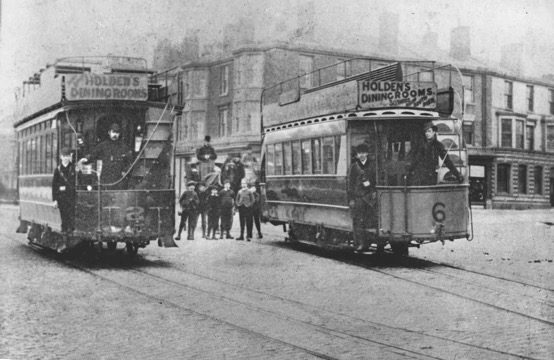
Two conduit cars (Numbers 2 and 6) captured for posterity on North Shore around 1888, i.e., in Blackpool Electric Tramways Company days. Photo courtesy of Brian Turner.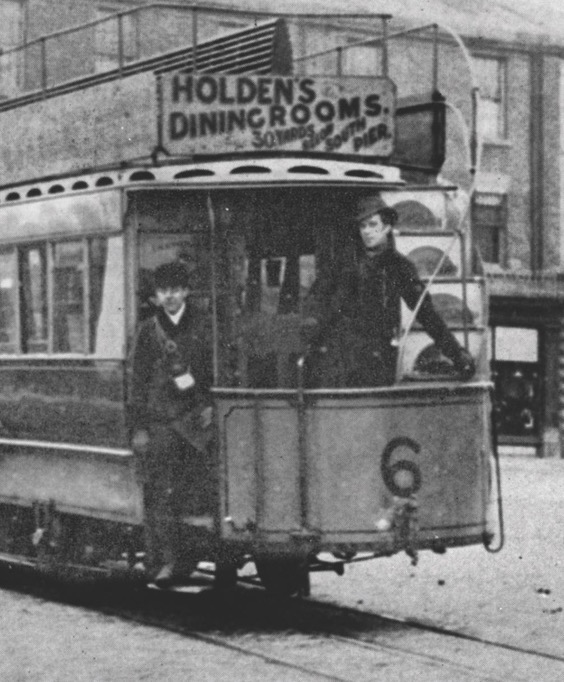
An enlargement of the above photograph showing the crew of Car No 6. Both the conductor and the motorman are wearing informal attire, the former in a close-fitting cap and the latter a bowler hat with upturned brim.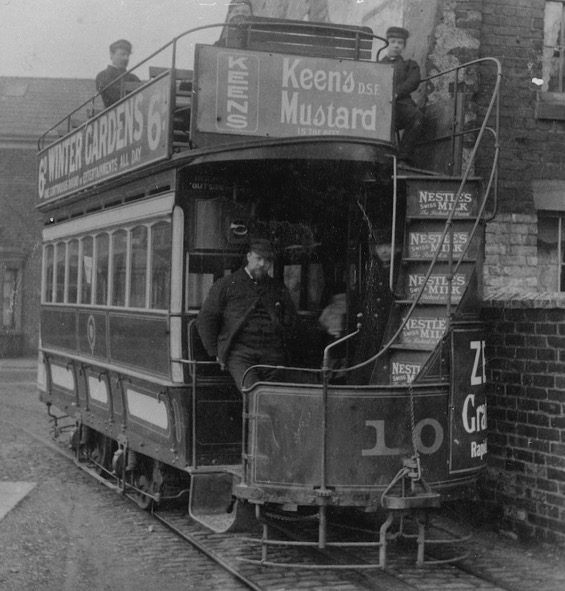
Conduit Tramcar No 10 stands at the approach to Princess Street car depot — photo undated, but probably taken shortly after the first jackets and caps were issued in 1894. All four individuals included in the image appear to be tramways staff, as they are all wearing the same style of jackets and soft-topped, peaked caps. Author's Collection.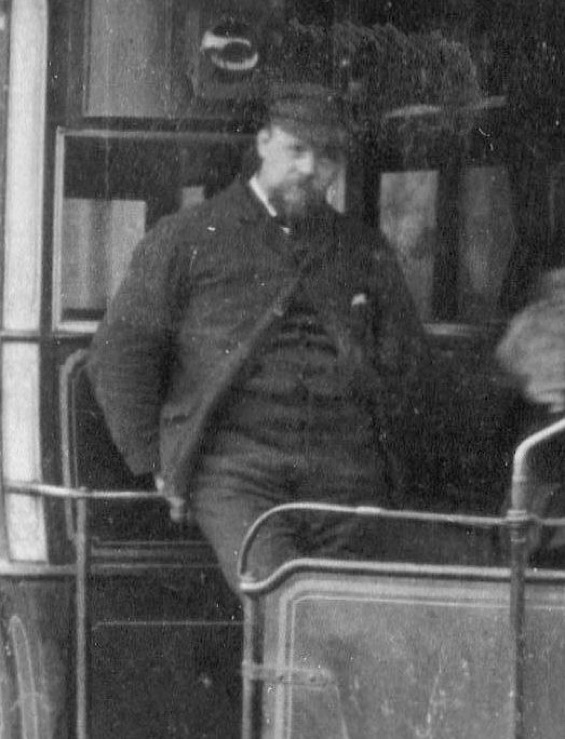
An enlargement of the above photograph showing the individual leaning on the bulkhead. He is wearing a corporation-issued jacket, devoid of metal buttons and insignia.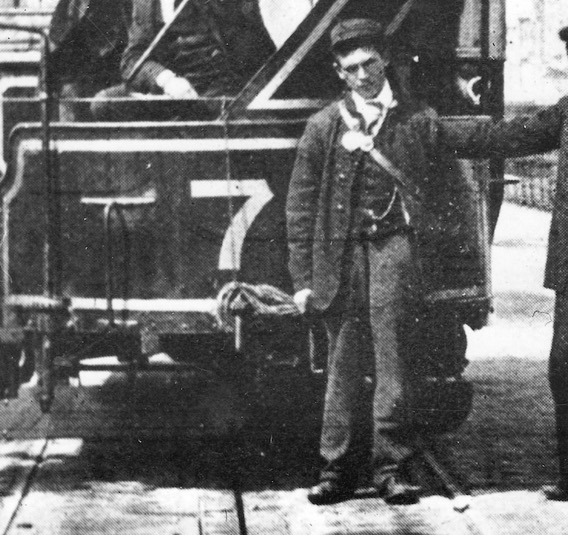
A rather youthful-looking conductor stands in front of Conduit Car No 7 — photo probably taken in 1895, i.e., under corporation ownership. He is wearing a kepi-style cap and what is probably a uniform jacket, though there appear to be no insignia, just a circular licence badge. Author's Collection.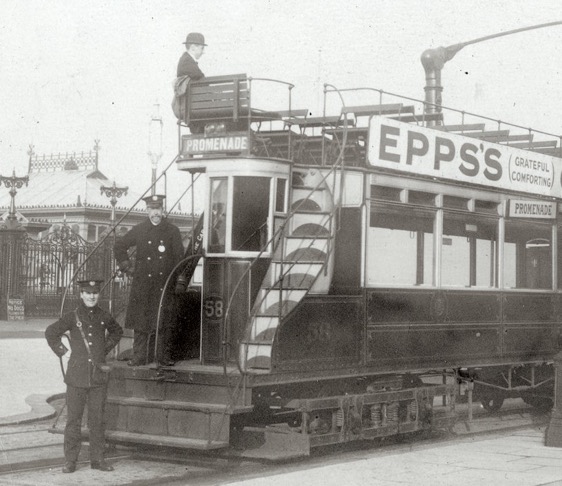
The crew of a pristine-looking Tramcar No 58 (a 'dreadnought') captured for posterity with their charge on the promenade — photo undated, but given the condition of the tram, probably taken not too long after its delivery in 1902. Author's Collection.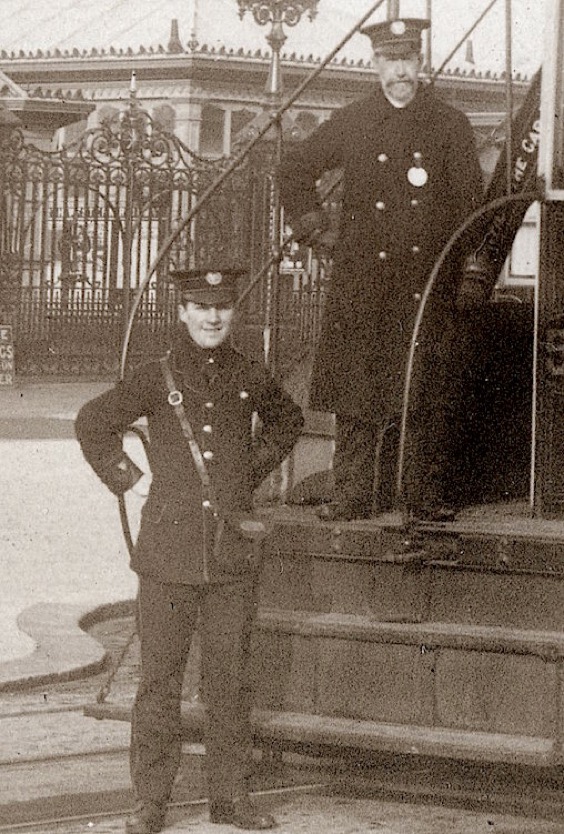
An enlargement of the above photograph showing the crew in more detail. The conductor's uniform jacket is single-breasted with lapels, and is heavily piped; his cap bears a large circular cap badge.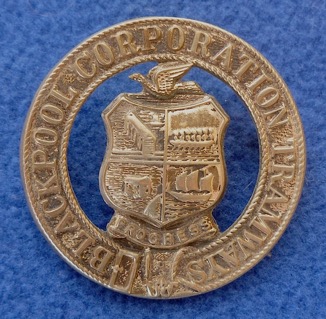
Blackpool Corporation Tramways cap badge — nickel. This badge uses an unofficial municipal device that was superseded in 1899. Significant numbers of these badges have survived, all with fairly heavy wear, suggesting that they saw plenty of use, probably from the mid 1890s through to 1910. Author's Collection.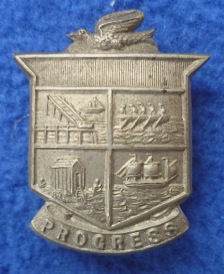
Blackpool Corporation municipal-device badge — nickel. This pattern of badge was potentially used on uniform epaulettes prior to 1899, though this is yet to be proven photographically. Author's Collection.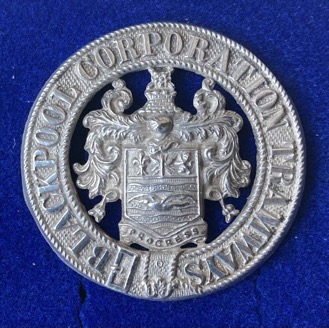
Blackpool Corporation Tramways cap badge bearing the official municipal arms (granted by the College of Heralds in June 1899) — nickel. This pattern of cap badge appears to have been worn from around 1900 through to 1910, though it was probably only issued to new starters rather than a wholesale replacement of the older badges. Author's Collection.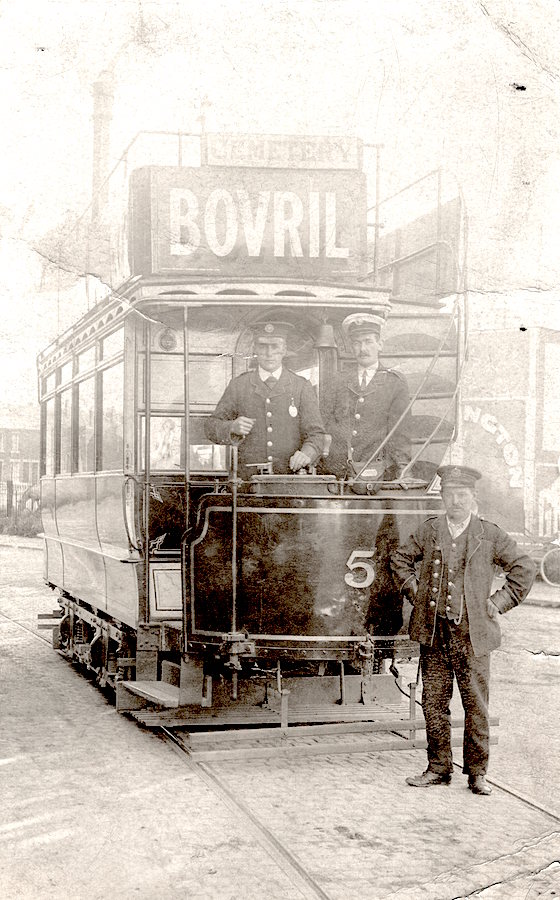
Three Blackpool Corporation Tramways men stand at Layton terminus with former conduit car No 5, converted to overhead electric supply. Although undated, the photograph was probably taken around 1909, after this car had been rebuilt with four windows. My thanks to Brian Turner for the dating and location. Author's Collection.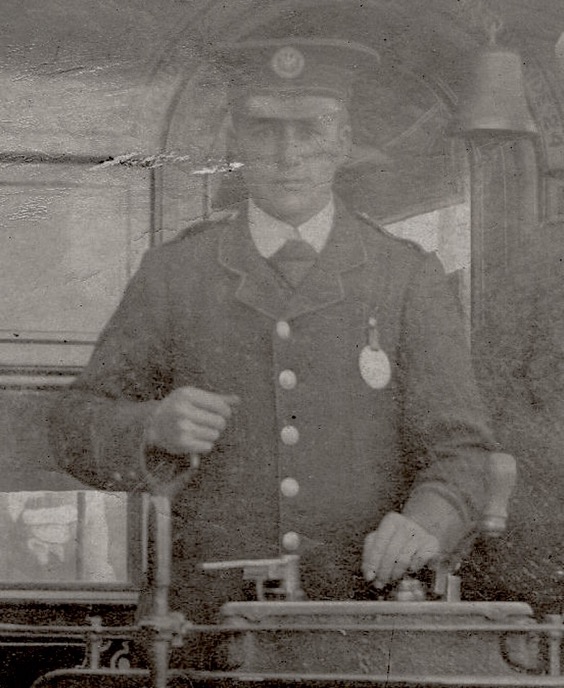
An enlargement of the above photograph showing the motorman. He is wearing a heavily piped, single-breasted jacket with lapels and epaulettes, which apart from a licence badge (suspended from a button) is completely devoid of insignia. His tensioned-crown peaked cap bears the large circular cap badge with the 1899 municipal device (see above).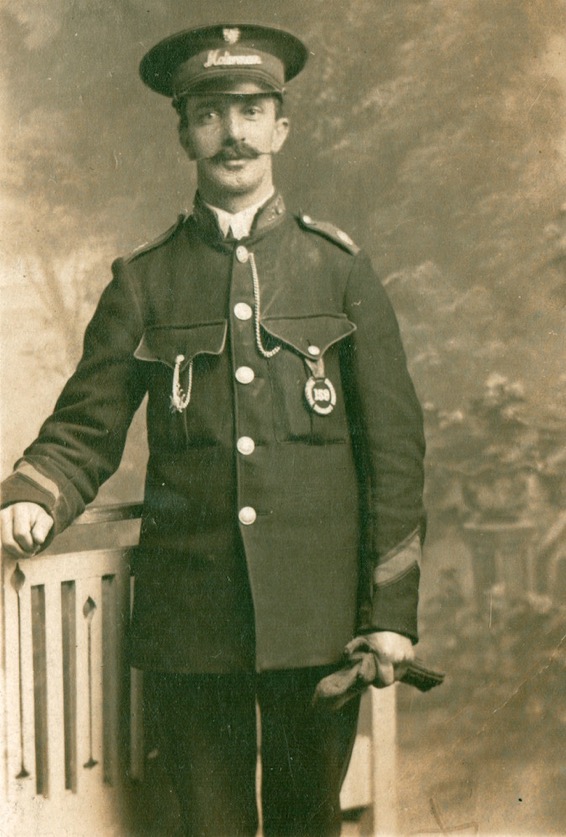
Motorman Joseph Edward Heywood Arnold — photo undated, but probably taken in 1910. The subject subsequently worked for Glossop Tramways (he is described as a motorman and conductor in the 1911 census) and eventually moved to Barrow around 1913 when he would have been 40 years old. Thanks to Karen Burns — Joseph's great granddaughter — for the photo and the background information.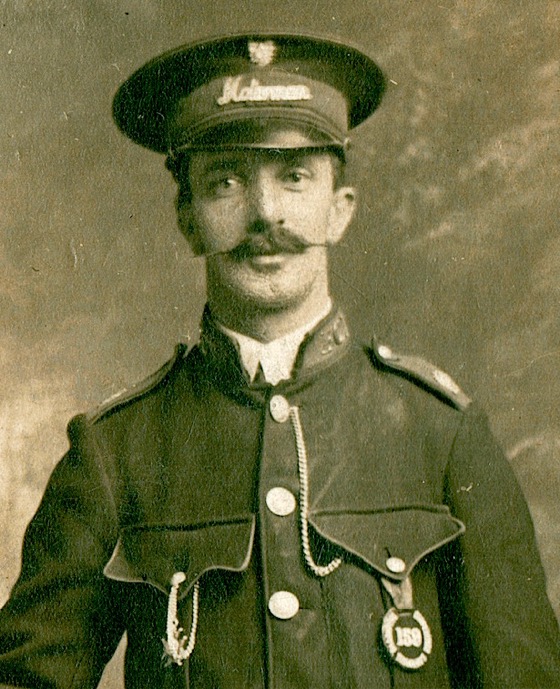
An enlargement of the above photograph showing details of the uniform, including the licence badge, which is No 159. The uniform has bright-blue facings on the collars, epaulettes and sleeves, the latter in the form of chevrons. The cap is also faced in bright blue; the top of the municipal-device cap badge is obscured by the crown (top of the cap). The municipal arms badge can just be made out on the epaulettes.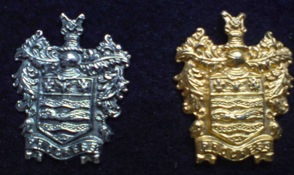
Blackpool Corporation municipal-device badges (1899 version) — nickel and gilded brass. This pattern of badge was used on the caps and epaulettes from 1910, and later on the jacket collars. Author's Collection.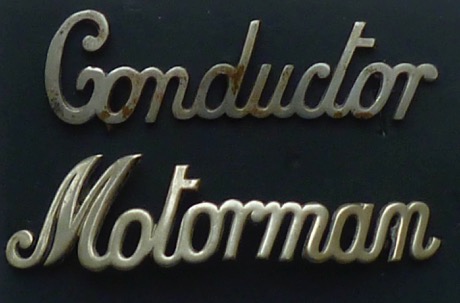
Standard 'off-the-shelf' script-lettering grade badges of the type worn on corporation tramcar crew caps from 1910 onwards — nickel. Author's Collection.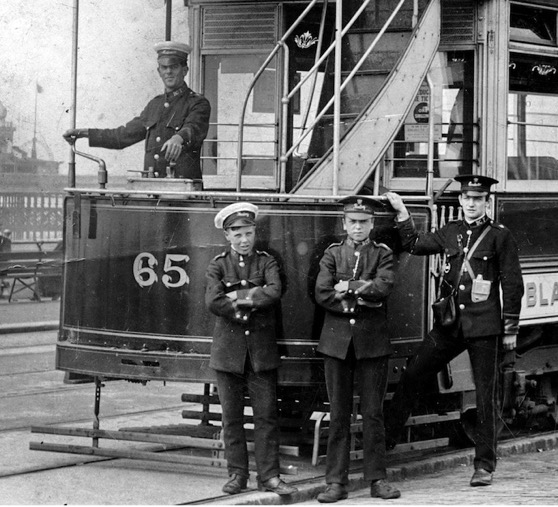
The crew of Tramcar No 65 stand on North Shore, along with two junior members of staff — photo undated, but given the pristine condition of the tram, probably taken in, or shortly after, 1911, when this vehicle was built.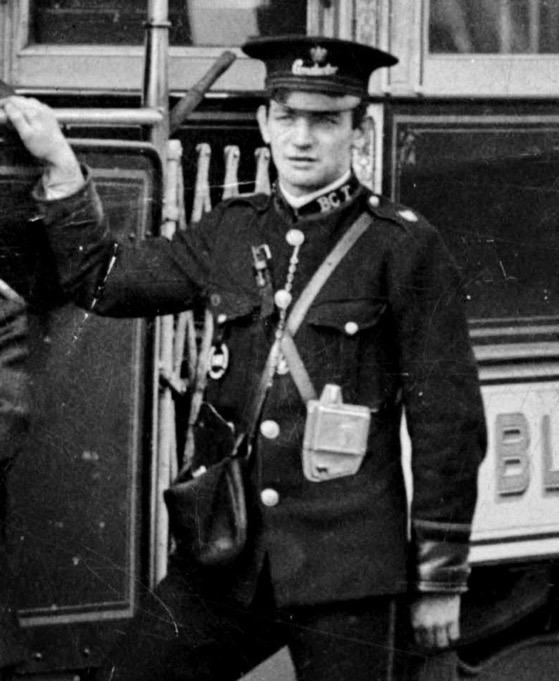
An enlargement of the above photograph showing the conductor. Unlike the other three subjects, his uniform is much darker, with much subtler bright-blue facings than the 1910 uniforms.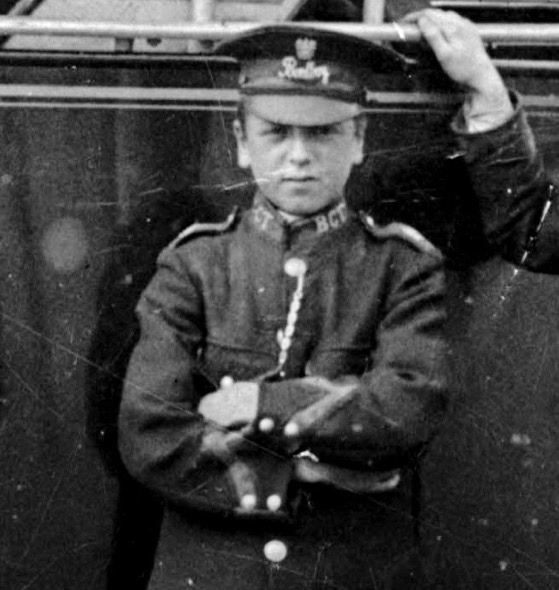
Another blow-up of the photo of No 65 above showing one of the two extremely youthful looking lads. His cap badge appears to say Parcelsboy. His uniform is the original 1910 issue with prominent bright-blue facings.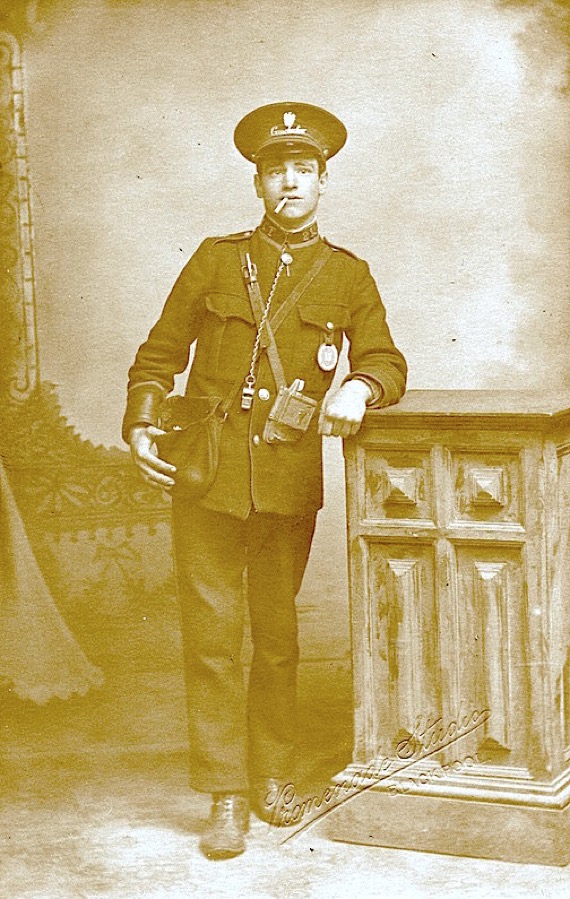
A studio portrait (taken at the Promenade Studios) of a Blackpool conductor — photo undated, but probably taken just prior to the Great War. Author's Collection.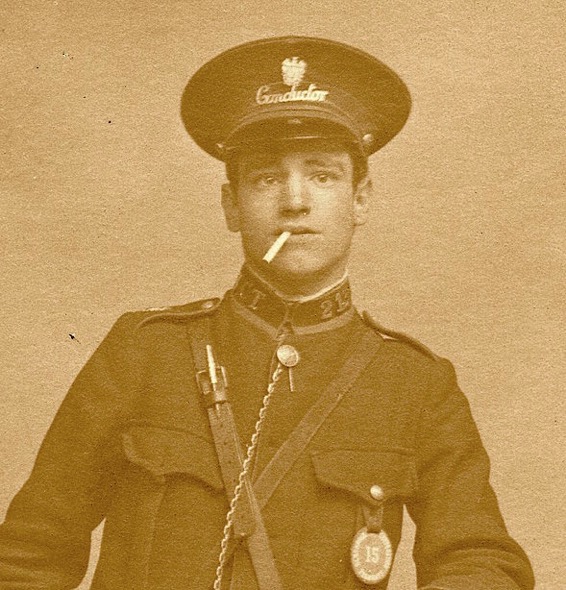
An enlargement of the above photograph revealing the subject to be Employee No 213, bearer of Licence Badge No 15. By this time, the system initials on the bearer's left-hand collar had been replaced by an employee number. Note the much subtler use of bright-blue facings/embellishments.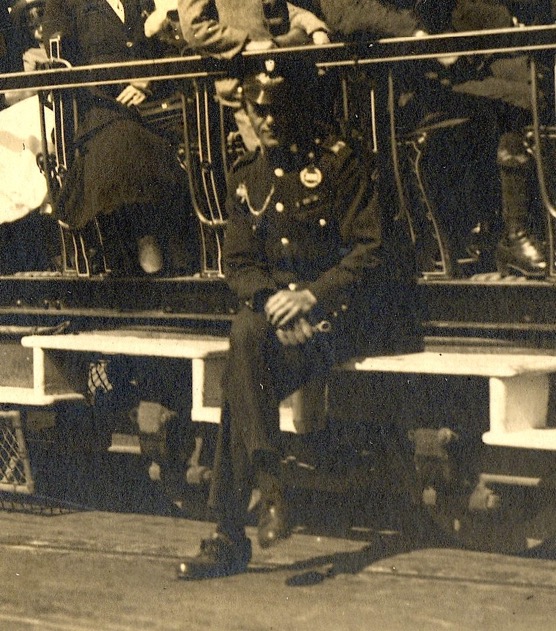
A motorman poses for the camera on the running board of a toastrack tram — photo undated, but possibly taken in early the 1920s given the passengers' attire and the fact that the subject is wearing a medal ribbon. Author's Collection.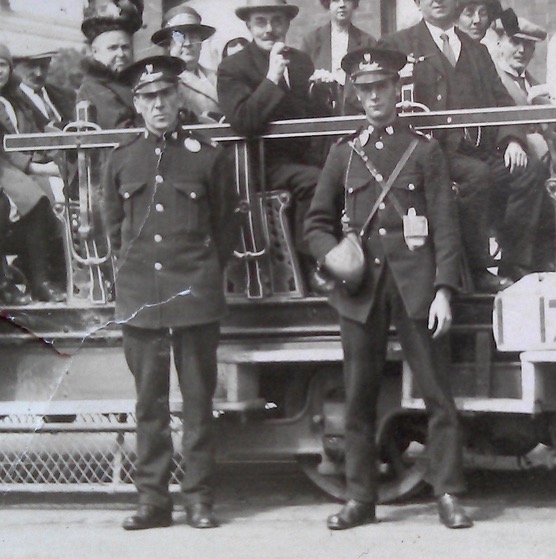
A motorman and a conductor pose with a fully laden 'toastrack' tramcar — photo undated, but probably taken in the 1920s. The collar initials had by this time been displaced by small municipal-device badges, identical to those worn on the caps. Both men are wearing licence badges suspended from their epaulette buttons. With thanks to Daniel Smith.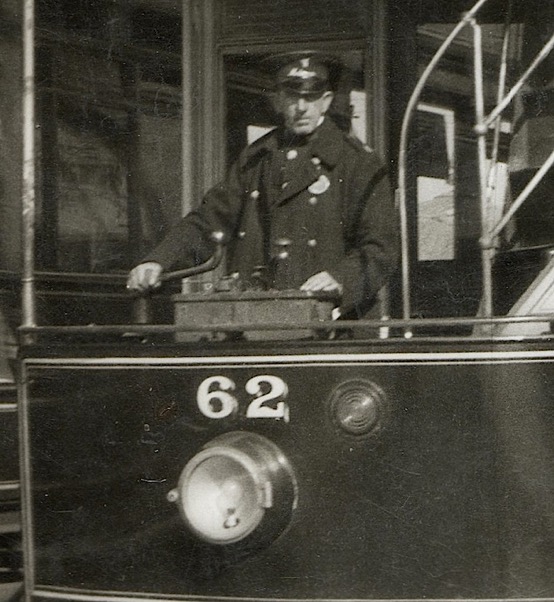
A Blackpool Corporation Tramways motorman at the controls of No 62 on a service to Squires Gate — July 1932. Author's Collection.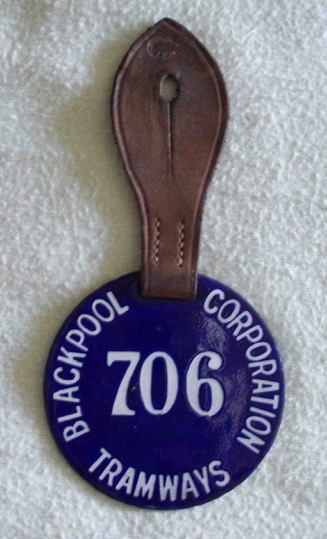
Licence Badge No 706 — blue and white enamel. Author's Collection.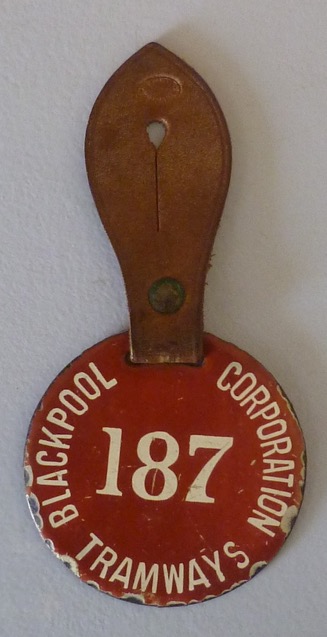
Licence Badge No 187 — deep red and white enamel. Author's Collection.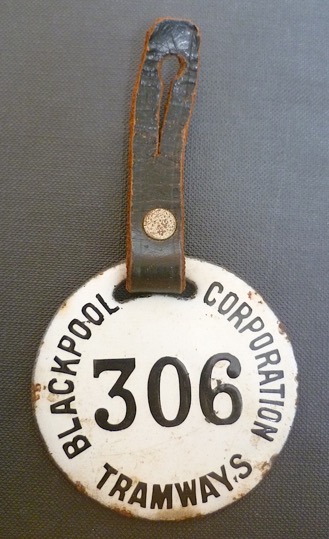
Licence Badge No 306 — white and black enamel. Author's Collection.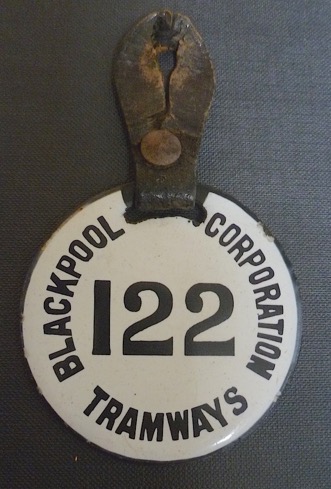
Licence Badge No 122 — white and black enamel with black rim. Author's Collection.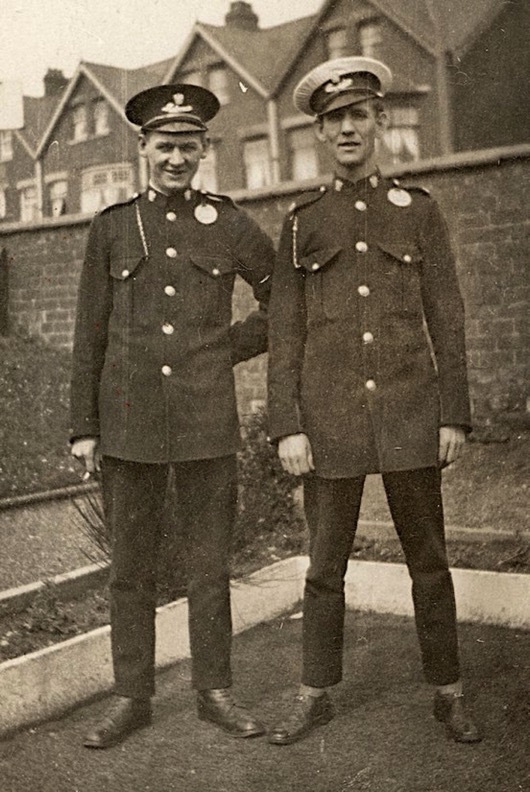
Two rather likely looking BCT tramway men, possibly conductors — photo undated, but probably taken in the 1930s. Author's Collection.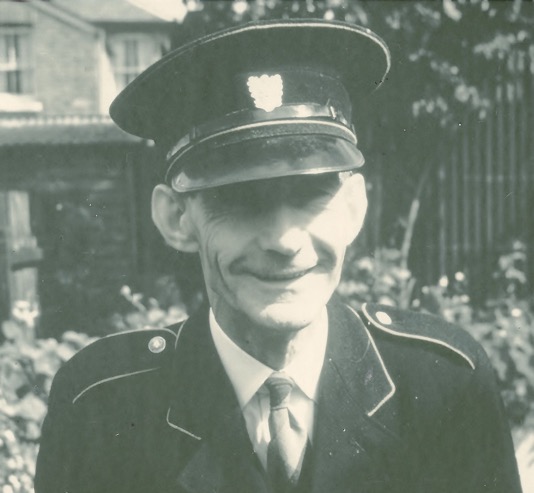
A Blackpool Corporation Transport employee — photo undated, but probably taken in the 1950s or 1960s. Photo courtesy of the Stephen Howarth Collection.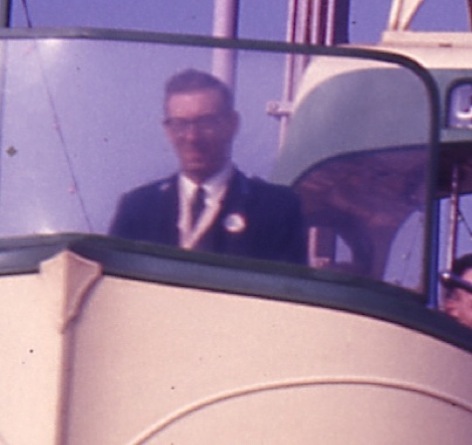
A motorman at the controls of an open-topped tram in 1963. He is clearly wearing a red and white PSV bus driver's badge, suggesting that he was also licenced to drive buses, though Blackpool may in fact have licensed all its staff irrespective of the fact that this was not a requirement of the PSV licensing laws. Photograph courtesy of the Tramway and Light Railway Society.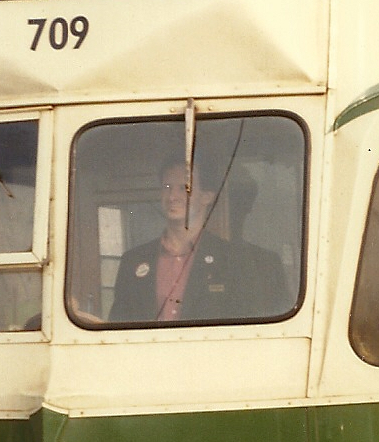
A motorman at the controls of Tramcar No 709 — photo undated, but possibly taken in the late 1970s. Stephen Howarth Collection.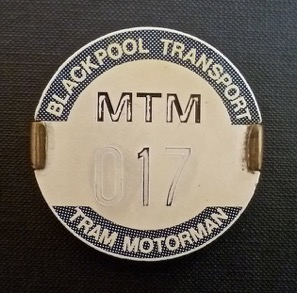
Blackpool Corporation Transport motorman's badge — probably issued after 31st July 1980. Author's Collection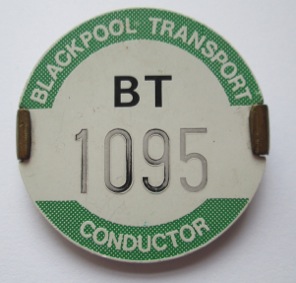 .
.
Blackpool Corporation Transport conductor's badge — probably issued after 31st July 1980. Stephen Howarth Collection.
Senior staff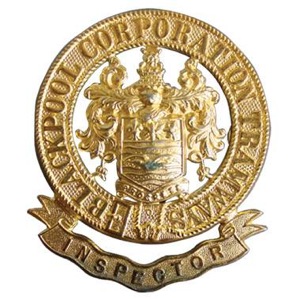
BCT inspector's cap badge, with the form of municipal arms granted in June 1899 — gilt. With thanks to Talisman Auctions).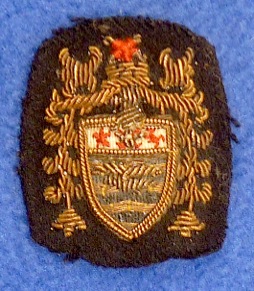
Possible later-era inspector's lapel/collar badge — cloth. Author's Collection.
Female staff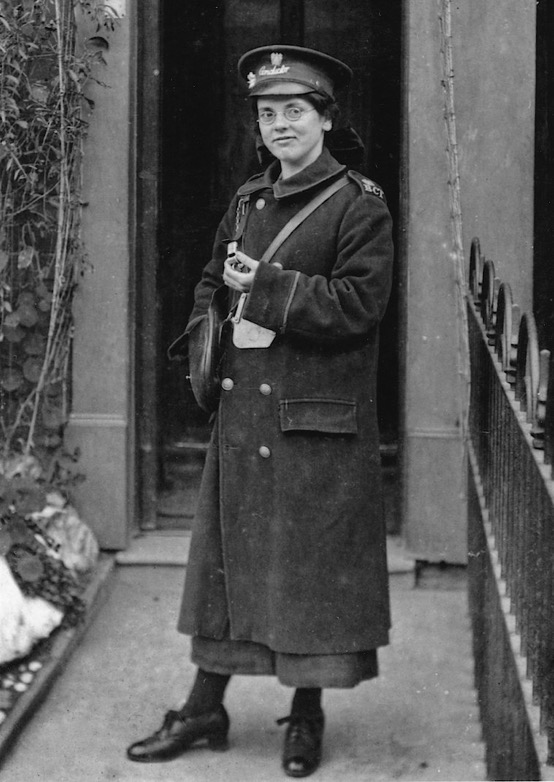
A diminutive and rather cheeky looking Great War Blackpool conductress — photo undated, but probably taken within the first few months of women being employed, as she is clearly wearing a man's cap, and probably a man's greatcoat too.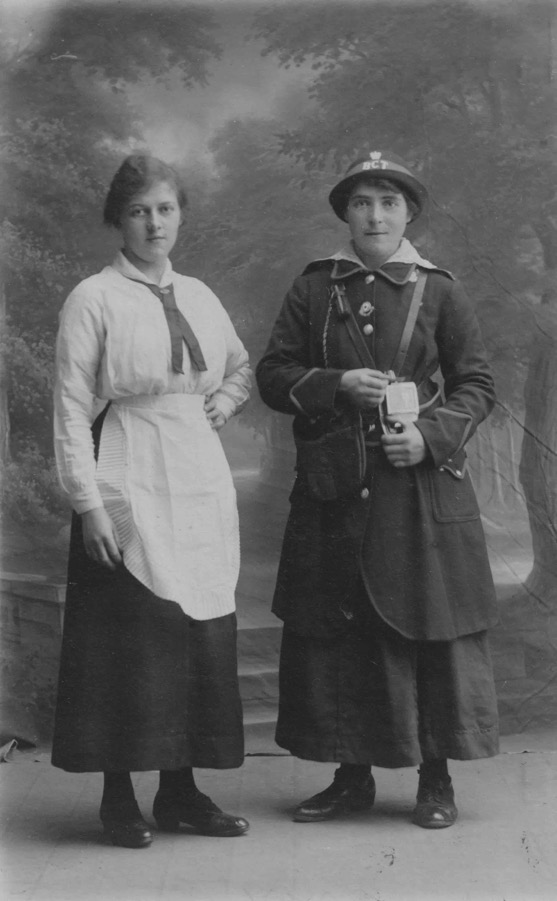
A delightful studio portrait of a Blackpool Corporation Tramways Great War conductress, along with either her friend or a relative. The photograph was taken in the studios of Cooper Brothers on the Promenade. Author's Collection.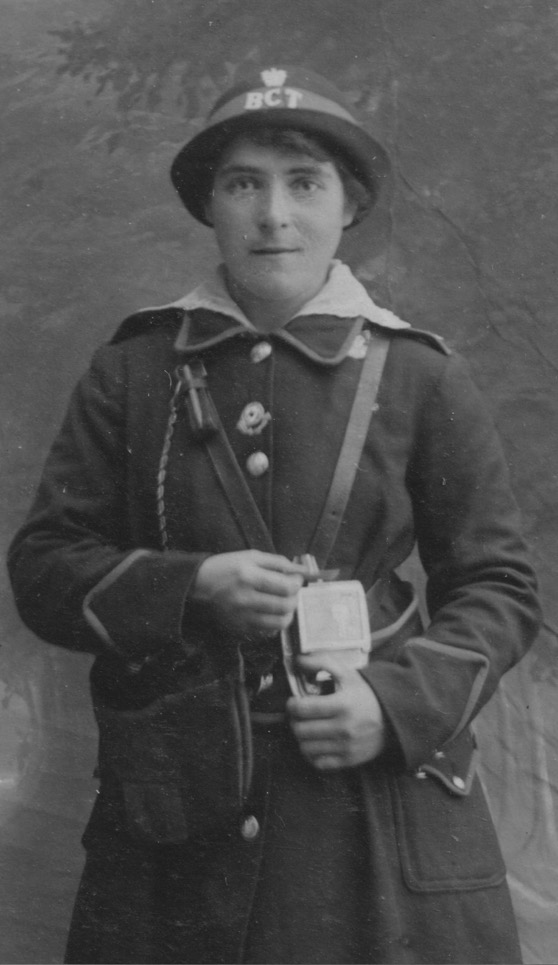
An enlargement of the above photograph showing details of the tailored uniform. Unlike most other photographs, the subject, who is clearly a conductress, is wearing a smart, three-quarter-length coat that is heavily piped, along with a felt bonnet; the latter bears the standard municipal-device badge and individual system initials. The style of uniform is probably that introduced in 1918, which replaced an earlier loose-fitting version without the piping and with high, fold-over collars. Documentary evidence indicates that the main body of the uniform was navy blue, and that the broad piping was green.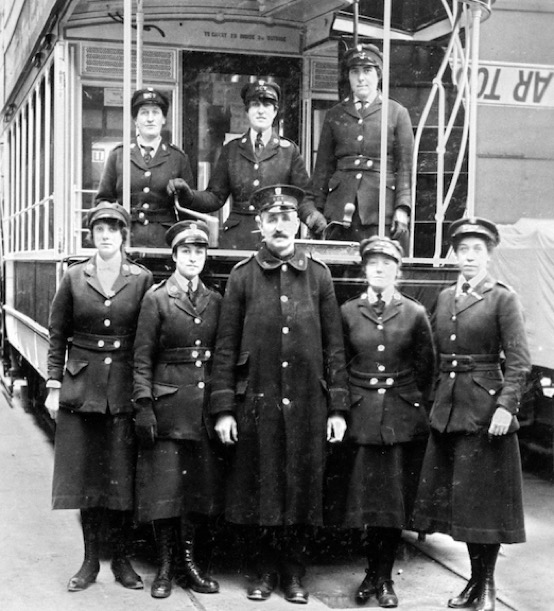
A depot shot of a group of Great War female employees, at least some of whom, and probably all of whom, appear to be motorwomen (judging by the gloves) – photo believed to have been taken in Marton depot in 1917.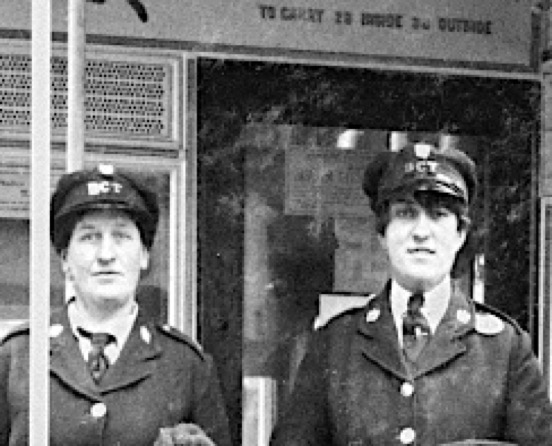
An enlargement of the above photograph showing details of the baggy motor caps, which bear 'B C T' system initials. Both ladies appear to be wearing the standard Blackpool municipal-device badges on their caps and collars; the lady on the right also has a municipal licence badge hanging from her epaulette closure button.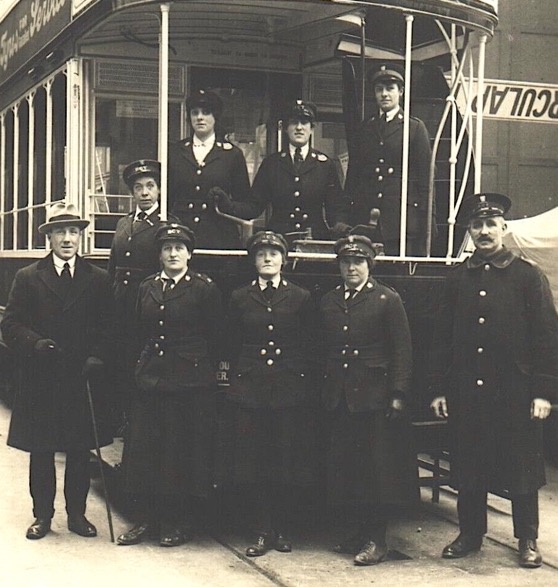
A different shot, but one clearly taken at the same time as the preceding photograph.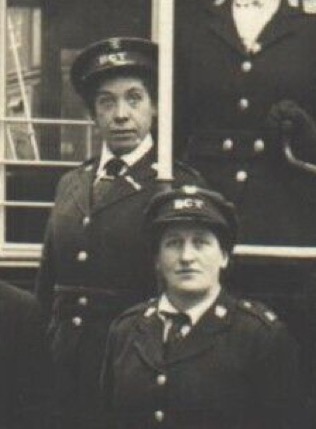
An enlargement of the above photograph showing the lady standing on the platform steps, who is in all likelihood an inspectress. She is wearing a tensioned-crown cap rather than the baggy motor caps that the others are wearing, and she also has a badge on her left lapel, very probably her grade.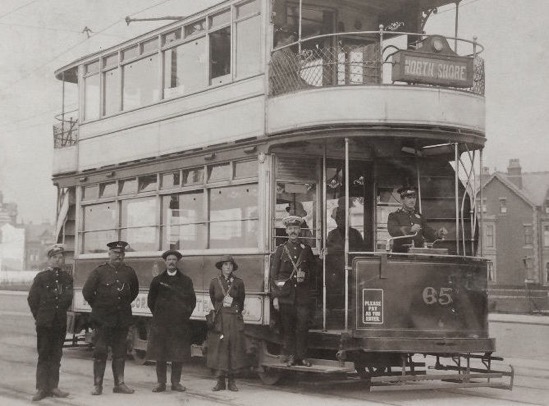
A Blackpool conductress along with various other staff and Tramcar No 65 — photo undated, but almost certainly taken during or shortly after the Great War. She appears to be wearing a waterproof bonnet.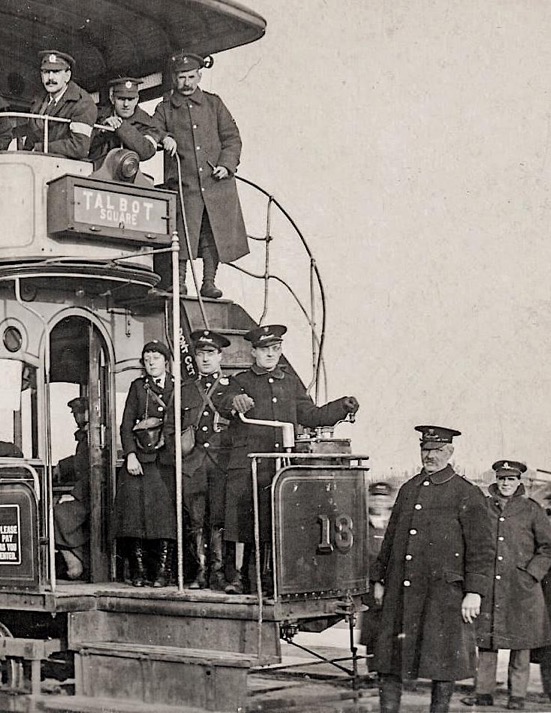
A rather uncomfortable-looking BCT conductress on the platform of a Tramcar No 13 at Squires Gate, along with various other tramway staff and Great War soldiers — photo undated, but thought to have been taken in 1918.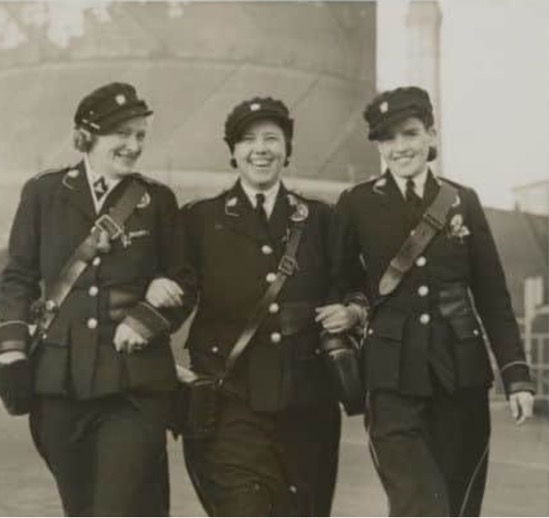
A photograph that is unfortunately not particularly sharp, but which does, however, show the uniform issued to conductresses during and after the Second World War — photo undated, but probably taken in the 1940s. The uniform jackets are heavily piped, whilst the caps are of a design reminiscent of military field caps, with a pleated crown and a cloth peak. Photo courtesy of the Stephen Howarth Collection.